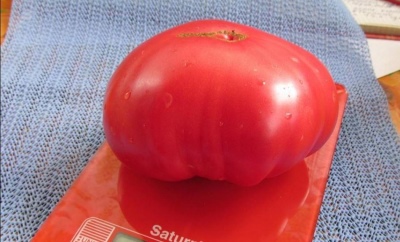
- Authors: Mamedov M., Sirota S.M., Mitina E.V., Korneev P.S., Korneev A.P., Mikheeva A.V.
- Year of approval: 2019
- Category: grade
- Growth type: indeterminate
- Appointment: fresh consumption
- Ripening period: mid-season
- Ripening time, days: 105
- Growing conditions: for film greenhouses
- Marketability: high
- Bush size: tall
Most often, gardeners grow several types of tomatoes on the site - for fresh eating, for whole-fruit canning and for processing for dressings, juices, salads. It is for processing that it will be ideal to grow a mid-season tomato variety called Korneevsky.
Breeding history
This mid-season tomato variety is the result of the work of domestic breeders (Korneev, Sirota, Mitina, Mikheeva and others). The nightshade crop was bred for quite a long time, but it was included in the State Register of Breeding Achievements of the Russian Federation and was approved for use only in 2019. Recommended for cultivation in all regions, including areas with cool climates and short summer seasons. The most productive crop is growing in film greenhouses, however, the variety also showed itself well in the garden.
Description of the variety
Korneevsky is a tall shrub of an indeterminate type, reaching a height of 170-180 cm. It is characterized by a strong central stem, moderate foliage (medium leaves, bright green color), medium branching and a complex type of inflorescence. As a rule, 3-4 fruit clusters with 4-6 berries in each are formed on the bush. The root system of the plant is powerful. According to the recommendation of specialists, the bush needs to be formed into 2 stems, an obligatory garter to the support, otherwise the stems will break under the weight of the tomatoes, and regular pinching.
The main qualities of the fruit
Tomatoes Korneevsky large-fruited. The average weight of a berry is 250 grams, sometimes it grows much more - up to 400-600 g. The largest tomatoes grow on the lower branches. The color of tomatoes in a state of ripeness is bright crimson, uniform, and when unripe, the fruits are light green. The shape of the tomato is flat-round, with a weakly pronounced ribbing.
Thanks to the thin, but dense, glossy peel, the fruits tolerate transportation well, and are stored for a long time if the conditions are met. Tomatoes that are harvested a little unripe are best kept. This variety is ideal for processing into sauces, purees, dressings, ketchups, and also for eating fresh.
Taste characteristics
The taste of the fruit is delicious - bright sweetness without a hint of sourness. The pulp of a tomato is fleshy, rather sugary, juicy, moderately dense, practically without seeds. In addition, there is no wateriness in the vegetable, which is observed in many similar varieties of tomatoes.
Ripening and fruiting
Korneevsky belongs to the group of mid-season varieties. Full maturation occurs on the 105th day after full germination. Tomatoes ripen gradually, without crumbling even at full maturity. The culture is characterized by a long fruiting phase, so you can enjoy delicious tomatoes for several months. The tasting period starts at the end of July.
Yield
The yield of the Korneevsky culture is very high. Subject to agricultural technology from one square. m you can remove 8-8.5 kg of berries.
The timing of planting seedlings and planting in the ground
At the end of March, you can sow seeds for seedlings, that is, 60-70 days before transferring to the garden or 50-60 days before transferring to the greenhouse. The seed is preliminarily treated with a growth stimulator.In the phase of appearance on the bushes of 2-3 real leaves, you can dive seedlings in separate pots. 7-10 days before transferring to a permanent place, it is necessary to harden the bushes, which will ensure the quick adaptation of the tomatoes to the new environment.
Planting seedlings in open ground is carried out in early June, in a film greenhouse 10-14 days earlier (end of May).

Growing tomato seedlings is an extremely important process, because it largely depends on whether the gardener will be able to harvest at all. All aspects must be taken into account, from seedbed preparation to planting in the ground.
Landing scheme
It is recommended to grow bushes, observing the planting density. For Korneevsky tomatoes, it is as follows: 2-3 bushes per 1 m2. Optimal for planting is a 60 x 40 cm pattern.

Growing and care
For growing tomatoes, loose, moderately moist, breathable and fertilized soil is considered ideal, which is pre-cleared of weeds.
A good harvest of tomatoes will ensure proper care of the plant, including watering with settled water, fertilizing, loosening and mulching the soil, shaping and tying bushes, removing stepchildren, and preventing viruses.




A plant needs different micronutrients at each stage of growth. All fertilizers can be divided into two groups: mineral and organic. Folk remedies are often used: iodine, yeast, bird droppings, eggshells.
It is important to observe the rate and period of feeding. This also applies to folk remedies and organic fertilizers.
Disease and pest resistance
The plant has resistance to many diseases, however, it sometimes becomes infected with root rot and late blight. Spraying with preparations containing copper will help prevent diseases. Spraying with insecticidal preparations will be a good protection against pests (aphids, thrips, spider mites).


Resistant to adverse weather conditions
Tomato tolerates sharp temperature fluctuations, so it can be grown in any climatic zone. The only thing that the culture does not like is the high humidity caused by the lingering rains. In addition, the variety is frost-resistant.

























































































